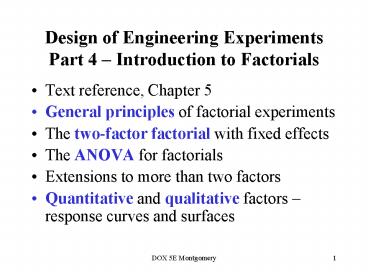Design of Engineering Experiments Part 4 Introduction to Factorials - PowerPoint PPT Presentation
1 / 24
Title:
Design of Engineering Experiments Part 4 Introduction to Factorials
Description:
... of Temperature (Aliased) DOX 5E Montgomery ... Cubic 0.00 0 Aliased. Pure Error 18230.75 27 675.21 ' ... Cubic 25.98 0.7652 0.6956 0.5826 32410.22 Aliased ' ... – PowerPoint PPT presentation
Number of Views:118
Avg rating:3.0/5.0
Title: Design of Engineering Experiments Part 4 Introduction to Factorials
1
Design of Engineering ExperimentsPart 4
Introduction to Factorials
- Text reference, Chapter 5
- General principles of factorial experiments
- The two-factor factorial with fixed effects
- The ANOVA for factorials
- Extensions to more than two factors
- Quantitative and qualitative factors response
curves and surfaces
2
Some Basic Definitions
Definition of a factor effect The change in the
mean response when the factor is changed from low
to high
3
The Case of Interaction
4
Regression Model The Associated Response Surface
5
The Effect of Interaction on the Response Surface
Suppose that we add an interaction term to the
model
Interaction is actually a form of curvature
6
Example 5-1 The Battery Life ExperimentText
reference pg. 175
- A Material type B Temperature (A
quantitative variable) - What effects do material type temperature have
on life? - 2. Is there a choice of material that would
give long life regardless of temperature (a
robust product)?
7
The General Two-Factor Factorial Experiment
a levels of factor A b levels of factor B n
replicates This is a completely randomized design
8
Statistical (effects) model
Other models (means model, regression models) can
be useful
9
Extension of the ANOVA to Factorials (Fixed
Effects Case) pg. 177
10
ANOVA Table Fixed Effects Case
Design-Expert will perform the computations Text
gives details of manual computing (ugh!) see
pp. 180 181
11
Design-Expert Output Example 5-1
Response Life ANOVA for Selected
Factorial Model Analysis of variance table
Partial sum of squares Sum of
Mean F Source Squares
DF Square Value Prob gt F Model
59416.22 8 7427.03 11.00 lt 0.0001 A
10683.72 2 5341.86 7.91 0.0020 B
39118.72 2 19559.36 28.97 lt
0.0001 AB 9613.78 4 2403.44 3.56
0.0186 Pure E 18230.75 27
675.21 C Total 77646.97 35 Std.
Dev. 25.98 R-Squared 0.7652 Mean 105.53 Adj
R-Squared 0.6956 C.V. 24.62 Pred
R-Squared 0.5826 PRESS 32410.22 Adeq
Precision 8.178
12
Residual Analysis Example 5-1
13
Residual Analysis Example 5-1
14
Residual Analysis Example 5-1
15
Interaction Plot
16
Quantitative and Qualitative Factors
- The basic ANOVA procedure treats every factor as
if it were qualitative - Sometimes an experiment will involve both
quantitative and qualitative factors, such as in
Example 5-1 - This can be accounted for in the analysis to
produce regression models for the quantitative
factors at each level (or combination of levels)
of the qualitative factors - These response curves and/or response surfaces
are often a considerable aid in practical
interpretation of the results
17
Quantitative and Qualitative Factors
Response Life WARNING The Cubic Model
is Aliased! Sequential Model Sum of
Squares Sum of Mean F Source Squares DF Square
Value Prob gt F Mean 4.009E005
1 4009E005 Linear 49726.39
3 16575.46 19.00 lt 0.0001 Suggested 2FI 2315.08
2 1157.54 1.36 0.2730 Quadratic 76.06
1 76.06 0.086 0.7709 Cubic 7298.69
2 3649.35 5.40 0.0106 Aliased Residual 18230.75
27 675.21 Total 4.785E005
36 13292.97 "Sequential Model Sum of Squares"
Select the highest order polynomial where the
additional terms are significant.
18
Quantitative and Qualitative Factors
Candidate model terms from Design- Expert
Intercept A B B2 AB B3 AB2
A Material type B Linear effect of
Temperature B2 Quadratic effect of
Temperature AB Material type TempLinear AB2
Material type - TempQuad B3 Cubic effect of
Temperature (Aliased)
19
Quantitative and Qualitative Factors
Lack of Fit Tests Sum of Mean F Source Squa
res DF Square Value Prob gt F Linear
9689.83 5 1937.97 2.87 0.0333 Suggested 2FI
7374.75 3 2458.25 3.64 0.0252 Quadratic
7298.69 2 3649.35 5.40 0.0106 Cubic
0.00 0 Aliased Pure Error 18230.75
27 675.21"Lack of Fit Tests" Want the
selected model to have insignificant lack-of-fit.
20
Quantitative and Qualitative Factors
Model Summary Statistics Std.
Adjusted Predicted Source Dev. R-Squared
R-Squared R-Squared PRESS Linear 29.54 0.6404 0.
6067 0.5432 35470.60 Suggested 2FI 29.22 0.6702 0
.6153 0.5187 37371.08 Quadratic 29.67 0.6712 0.60
32 0.4900 39600.97 Cubic 25.98 0.7652 0.6956 0.58
26 32410.22 Aliased "Model Summary
Statistics" Focus on the model maximizing the
"Adjusted R-Squared" and the "Predicted
R-Squared".
21
Quantitative and Qualitative Factors
Response Life ANOVA for
Response Surface Reduced Cubic Model Analysis of
variance table Partial sum of squares Sum
of Mean F Source Squares DF Square Value Prob
gt F Model 59416.22 8 7427.03 11.00 lt
0.0001 A 10683.72 2 5341.86
7.91 0.0020 B 39042.67 1 39042.67
57.82 lt 0.0001 B2 76.06 1 76.06
0.11 0.7398 AB 2315.08 2 1157.54
1.71 0.1991 AB2 7298.69 2 3649.35
5.40 0.0106 Pure E 18230.75 27 675.21 C
Total 77646.97 35 Std. Dev. 25.98 R-Squared
0.7652 Mean 105.53 Adj R-Squared 0.6956 C.V. 2
4.62 Pred R-Squared 0.5826 PRESS 32410.22 Adeq
Precision 8.178
22
Regression Model Summary of Results
Final Equation in Terms of Actual Factors
Material A1 Life 169.38017 -2.50145
Temperature 0.012851 Temperature2
Material A2 Life 159.62397 -0.17335
Temperature -5.66116E-003 Temperature2
Material A3 Life 132.76240 0.90289
Temperature -0.010248 Temperature2
23
Regression Model Summary of Results
24
Factorials with More Than Two Factors
- Basic procedure is similar to the two-factor
case all abckn treatment combinations are run
in random order - ANOVA identity is also similar
- Complete three-factor example in text, Section 5-4































